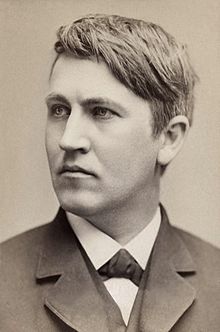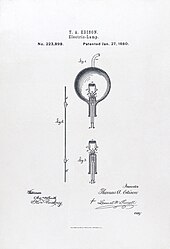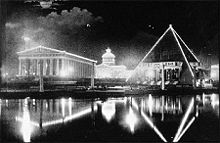History:-
Thomas Alva Edison (February 11, 1847 – October 18, 1931) was an American inventor, scientist, and businessman who developed many devices that greatly influenced life around the world, including the phonograph, the motion picture camera, and a long-lasting, practical electric light bulb. Dubbed "The Wizard of Menlo Park" (now Edison, New Jersey) by a newspaper reporter, he was one of the first inventors to apply the principles of mass production and large teamwork to the process of invention, and therefore is often credited with the creation of the first industrial research laboratory.
Edison is the third most prolific inventor in history, holding 1,093 US patents in his name, as well as many patents in the United Kingdom, France, and Germany. He is credited with numerous inventions that contributed to mass communication and, in particular,telecommunications. These included a stock ticker, a mechanical vote recorder, a battery for an electric car, electrical power, recorded music and motion pictures. His advanced work in these fields was an outgrowth of his early career as a telegraph operator. Edison originated the concept and implementation of electric-power generation and distribution to homes, businesses, and factories – a crucial development in the modern industrialized world. His first power station was on Manhattan Island, New York.
Science:-
Carbon telephone transmitter
In 1877–78, Edison invented and developed the carbon microphone used in all telephones along with the Bell receiver until the 1980s. After protracted patent litigation, in 1892 a federal court ruled that Edison—and not Emile Berliner—was the inventor of the carbon microphone. The carbon microphone was also used in radio broadcasting and public address work through the 1920s.
Electric light
Main article: History of the light bulb
Building on the contributions of other developers over the previous three quarters of a century, Edison made significant improvements to the idea of incandescent light, and wound up in the public consciousness as "the inventor" of the lightbulb, and a prime mover in developing the necessary infrastructure for electric power.
After many experiments with platinum and other metal filaments, Edison returned to a carbon filament. The first successful test was on October 22, 1879; it lasted 40 hours. Edison continued to improve this design and by November 4, 1879, filed for U.S. patent 223,898 (granted on January 27, 1880) for an electric lamp using "a carbon filament or strip coiled and connected to platina contact wires". Although the patent described several ways of creating the carbon filament including "cotton and linen thread, wood splints, papers coiled in various ways", it was not until several months after the patent was granted that Edison and his team discovered a carbonized bamboo filament that could last over 1,200 hours. The idea of using this particular raw material originated from Edison's recalling his examination of a few threads from a bamboo fishing pole while relaxing on the shore of Battle Lake in the present-day state of Wyoming, where he and other members of a scientific team had traveled so that they could clearly observe a total eclipse of the sun on July 29, 1878, from the Continental Divide.
In 1878, Edison formed the Edison Electric Light Company in New York City with several financiers, including J. P. Morgan and the members of the Vanderbilt family. Edison made the first public demonstration of his incandescent light bulb on December 31, 1879, in Menlo Park. It was during this time that he said: "We will make electricity so cheap that only the rich will burn candles."
Lewis Latimer joined the Edison Electric Light Company in 1884. Latimer had received a patent in January 1881 for the "Process of Manufacturing Carbons", an improved method for the production of carbon filaments for lightbulbs. Latimer worked as an engineer, a draftsman and an expert witness in patent litigation on electric lights.
George Westinghouse's company bought Philip Diehl's competing induction lamp patent rights (1882) for $25,000, forcing the holders of the Edison patent to charge a more reasonable rate for the use of the Edison patent rights and lowering the price of the electric lamp.
On October 8, 1883, the US patent office ruled that Edison's patent was based on the work of William Sawyer and was therefore invalid. Litigation continued for nearly six years, until October 6, 1889, when a judge ruled that Edison's electric light improvement claim for "a filament of carbon of high resistance" was valid. To avoid a possible court battle with Joseph Swan, whose British patent had been awarded a year before Edison's, he and Swan formed a joint company called Ediswan to manufacture and market the invention in Britain.
Mahen Theatre in Brno in what is now the Czech Republic, was the first public building in the world to use Edison's electric lamps, with the installation supervised by Edison's assistant in the invention of the lamp, Francis Jehl. In September 2010, a sculpture of three giant light bulbs was erected in Brno, in front of the theatre.
Electric power distribution
Edison patented a system for electricity distribution in 1880, which was essential to capitalize on the invention of the electric lamp. On December 17, 1880, Edison founded the Edison Illuminating Company. The company established the first investor-owned electric utility in 1882 on Pearl Street Station, New York City. It was on September 4, 1882, that Edison switched on his Pearl Street generating station's electrical power distribution system, which provided 110 volts direct current (DC) to 59 customers in lower Manhattan.
Earlier in the year, in January 1882 he had switched on the first steam generating power station at Holborn Viaduct in London. The DC supply system provided electricity supplies to street lamps and several private dwellings within a short distance of the station. On January 19, 1883, the first standardized incandescent electric lighting system employing overhead wires began service in Roselle, New Jersey.
War of currents
Main article: War of Currents
Edison's true success, like that of his friend Henry Ford, was in his ability to maximize profits through establishment of mass-production systems and intellectual property rights. George Westinghouse and Edison became adversaries because of Edison's promotion of direct current (DC) for electric power distribution instead of the more easily transmitted alternating current (AC) system invented by Nikola Tesla and promoted by Westinghouse. Unlike DC, AC could be stepped up to very high voltages with transformers, sent over thinner and cheaper wires, and stepped down again at the destination for distribution to users.
In 1887 there were 121 Edison power stations in the United States delivering DC electricity to customers. When the limitations of DC were discussed by the public, Edison launched a propaganda campaign to convince people that AC was far too dangerous to use. The problem with DC was that the power plants could economically deliver DC electricity only to customers within about one and a half miles (about 2.4 km) from the generating station, so that it was suitable only for central business districts. When George Westinghouse suggested using high-voltage AC instead, as it could carry electricity hundreds of miles with marginal loss of power, Edison waged a "War of Currents" to prevent AC from being adopted.
The war against AC led him to become involved in the development and promotion of the electric chair (using AC) as an attempt to portray AC to have greater lethal potential than DC. Edison went on to carry out a brief but intense campaign to ban the use of AC or to limit the allowable voltage for safety purposes. As part of this campaign, Edison's employees publicly electrocuted animals to demonstrate the dangers of AC; alternating electric currents are slightly more dangerous in that frequencies near 60 Hz have a markedly greater potential for inducing fatal "cardiac fibrillation" than do direct currents. On one of the more notable occasions, in 1903, Edison's workers electrocuted Topsy the elephant at Luna Park, near Coney Island, after she had killed several men and her owners wanted her put to death. His company filmed the electrocution.
AC replaced DC in most instances of generation and power distribution, enormously extending the range and improving the efficiency of power distribution. Though widespread use of DC ultimately lost favor for distribution, it exists today primarily in long-distance high-voltage direct current (HVDC) transmission systems. Low voltage DC distribution continued to be used in high-density downtown areas for many years but was eventually replaced by AC low-voltage network distribution in many of them. DC had the advantage that large battery banks could maintain continuous power through brief interruptions of the electric supply from generators and the transmission system. Utilities such as Commonwealth Edison in Chicago had rotary converters or motor-generator sets, which could change DC to AC and AC to various frequencies in the early to mid-20th century. Utilities supplied rectifiers to convert the low voltage AC to DC for such DC loads as elevators, fans and pumps. There were still 1,600 DC customers in downtown New York City as of 2005, and service was finally discontinued only on November 14, 2007. Most subway systems still are powered by direct current.
Fluoroscopy
Edison is credited with designing and producing the first commercially available fluoroscope, a machine that uses X-rays to take radiographs. Until Edison discovered that calcium tungstate fluoroscopy screens produced brighter images than the barium platinocyanide screens originally used by Wilhelm Röntgen, the technology was capable of producing only very faint images. The fundamental design of Edison's fluoroscope is still in use today, despite the fact that Edison himself abandoned the project after nearly losing his own eyesight and seriously injuring his assistant, Clarence Dally. Dally had made himself an enthusiastic human guinea pig for the fluoroscopy project and in the process been exposed to a poisonous dose of radiation. He later died of injuries related to the exposure. In 1903, a shaken Edison said "Don't talk to me about X-rays, I am afraid of them."
Work relations
Frank J. Sprague, a competent mathematician and former naval officer, was recruited by Edward H. Johnson and joined the Edison organization in 1883. One of Sprague's significant contributions to the Edison Laboratory at Menlo Park was to expand Edison's mathematical methods. Despite the common belief that Edison did not use mathematics, analysis of his notebooks reveal that he was an astute user of mathematical analysis conducted by his assistants such as Francis Robbins Upton, for example, determining the critical parameters of his electric lighting system including lamp resistance by a sophisticated analysis of Ohm's Law, Joule's Law and economics.
Another of Edison's assistants was Nikola Tesla. Tesla claimed that Edison promised him $50,000 if he succeeded in making improvements to his DC generation plants. Several months later, when Tesla had finished the work and asked to be paid, he said that Edison replied, "When you become a full-fledged American you will appreciate an American joke." Tesla immediately resigned. With Tesla's salary of $18 per week, the payment would have amounted to over 53 years' pay and the amount was equal to the initial capital of the company. Tesla resigned when he was refused a raise to $25 per week. Although Tesla accepted an Edison Medal later in life, this and other negative series of events concerning Edison remained with Tesla. The day after Edison died, the New York Times contained extensive coverage of Edison's life, with the only negative opinion coming from Tesla who was quoted as saying:
He had no hobby, cared for no sort of amusement of any kind and lived in utter disregard of the most elementary rules of hygiene. [...] His method was inefficient in the extreme, for an immense ground had to be covered to get anything at all unless blind chance intervened and, at first, I was almost a sorry witness of his doings, knowing that just a little theory and calculation would have saved him 90% of the labour. But he had a veritable contempt for book learning and mathematical knowledge, trusting himself entirely to his inventor's instinct and practical American sense.—Nikola Tesla
One of Edison's famous quotations regarding his attempts to make the light globe suggest that perhaps Tesla was right about Edison's methods of working: "If I find 10,000 ways something won't work, I haven't failed. I am not discouraged, because every wrong attempt discarded is another step forward."
When Edison was a very old man and close to death, he said, in looking back, that the biggest mistake he had made was that he never respected Tesla or his work.
There were 28 men recognized as Edison Pioneers.
Media inventions
The key to Edison's fortunes was telegraphy. With knowledge gained from years of working as a telegraph operator, he learned the basics of electricity. This allowed him to make his early fortune with the stock ticker, the first electricity-based broadcast system. Edison patented the sound recording and reproducing phonograph in 1878. Edison was also granted a patent for the motion picture camera or "Kinetograph". He did the electromechanical design, while his employee W.K.L. Dickson, a photographer, worked on the photographic and optical development. Much of the credit for the invention belongs to Dickson. In 1891, Thomas Edison built a Kinetoscope, or peep-hole viewer. This device was installed in penny arcades, where people could watch short, simple films. The kinetograph and kinetoscope were both first publicly exhibited May 20, 1891.
On August 9, 1892, Edison received a patent for a two-way telegraph. In April 1896, Thomas Armat's Vitascope, manufactured by the Edison factory and marketed in Edison's name, was used to project motion pictures in public screenings in New York City. Later he exhibited motion pictures with voice soundtrack on cylinder recordings, mechanically synchronized with the film.
Officially the kinetoscope entered Europe when the rich American Businessman Irving T. Bush (1869–1948) bought from the Continental Commerce Company of Franck Z. Maguire and Joseph D. Bachus a dozen machines. Bush placed from October 17, 1894, the first kinetoscopes in London. At the same time the French company Kinétoscope Edison Michel et Alexis Werner bought these machines for the market in France. In the last three months of 1894 The Continental Commerce Company sold hundreds of kinetoscopes in Europe (i.e. the Netherlands and Italy). In Germany and in Austria-Hungary the kinetoscope was introduced by the Deutsche-österreichische-Edison-Kinetoscop Gesellschaft, founded by the Ludwig Stollwerck of the Schokoladen-Süsswarenfabrik Stollwerck & Co of Cologne. The first kinetoscopes arrived in Belgium at the Fairs in early 1895. The Edison's Kinétoscope Français, a Belgian company, was founded in Brussels on January 15, 1895, with the rights to sell the kinetoscopes in Monaco, France and the French colonies. The main investors in this company were Belgian industrialists. On May 14, 1895, the Edison's Kinétoscope Belge was founded in Brussels. The businessman Ladislas-Victor Lewitzki, living in London but active in Belgium and France, took the initiative in starting this business. He had contacts with Leon Gaumontand the American Mutoscope and Biograph Co. In 1898 he also became a shareholder of the Biograph and Mutoscope Company for France.
In 1901, he visited the Sudbury area in Ontario, Canada, as a mining prospector, and is credited with the original discovery of the Falconbridgeore body. His attempts to actually mine the ore body were not successful, however, and he abandoned his mining claim in 1903. A street in Falconbridge, as well as the Edison Building, which served as the head office of Falconbridge Mines, are named for him.
In 1902, agents of Thomas Edison bribed a theater owner in London for a copy of A Trip to the Moon by Georges Méliès. Edison then made hundreds of copies and showed them in New York City. Méliès received no compensation. He was counting on taking the film to the US and recapture its huge cost by showing it throughout the country when he realized it had already been shown there by Edison. This effectively bankrupted Méliès. Other exhibitors similarly routinely copied and exhibited each others films. To better protect the copyrights on his films, Edison deposited prints of them on long strips of photographic paper with the U.S. copyright office. Many of these paper prints survived longer and in better condition than the actual films of that era.
Edison's favorite movie was The Birth of a Nation. He thought that talkies had "spoiled everything" for him. "There isn't any good acting on the screen. They concentrate on the voice now and have forgotten how to act. I can sense it more than you because I am deaf." His favorite stars were Mary Pickford and Clara Bow.
In 1908, Edison started the Motion Picture Patents Company, which was a conglomerate of nine major film studios (commonly known as the Edison Trust). Thomas Edison was the first honorary fellow of the Acoustical Society of America, which was founded in 1929.





